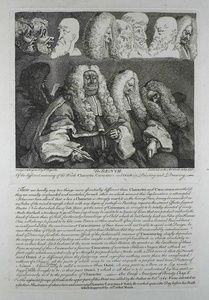| Method | Copper engraving and etching |
| Artist | William Hogarth |
| Published | Design'd & Engrav'd by W. Hogarth. Publish'd as the Act directs, 4 Sep. 1758. [J & J Boydell c.1795] |
| Dimensions | Image 173 x 198 mm, Plate 192 x 212 mm, Sheet 475 x 405 mm |
| Notes |
Another of Hogarth's comparisons between character and caricature, this time using a scene of the Common Pleas Court at Westminster Hall. The judges depicted are identified as William Noel, Sir John Willes, Henry, Earl Bathurst and Sir Edward Clive. Of the four, Willes is the best known. Despite his education and capability, he was best known for his dissolute lifestyle, thus fitting him neatly into the common character of the amoral judge. It is likely that he is the seducer in Hogarth's 'Before' and 'After.' Added to this was his the reputation of his changeable political allegiance. Initially a supporter of Walpole, he shifted his support first to Pelham, and finally to Pitt. Above the judges are a number of caricatures. The inscription below the title reads: Of the different meaning of the Words Character, Caracatura and Outrè in Painting and Drawing. The inscription on the plate below the image mocks and criticises the current trend for caricature and begins There are hardly any two things more essentially different than Character and Caracatura, and ends - see Excess, Analysis of Beauty, Chap. 6. This state has additional lettering at the bottom of the plate which reads: '*** The unfinish'd Groupe of Heads in the upper part of this Print was added by the Author in Octr 1764: & was intended as a further Illustration of what is here said concerning Character Caracatura & Outrè, He worked upon it the Day before his Death which happened the 26th. of that Month.' William Hogarth (1697 - 1764) was born in London, the son of an unsuccessful schoolmaster and writer from Westmoreland. After apprenticeship to a goldsmith, he began to produce his own engraved designs in about 1710. He later took up oil painting, starting with small portrait groups called conversation pieces. He went on to create a series of paintings satirising contemporary customs, but based on earlier Italian prints, of which the first was The Harlot's Progress (1731), and perhaps the most famous The Rake's Progress. His engravings were so plagiarised that he lobbied for the Copyright Act of 1735, commonly referred to as 'Hogarth's Act,' as a protection for writers and artists. During the 1730s Hogarth also developed into an original painter of life-sized portraits, and created the first of several history paintings in the grand manner. Paulson 205 v/vi, BM Satires 3662 Condition: Water stain to bottom of sheet, slightly affecting text at bottom of plate. |
| Framing | unmounted |
| Price | £250.00 |
| Stock ID | 38130 |

